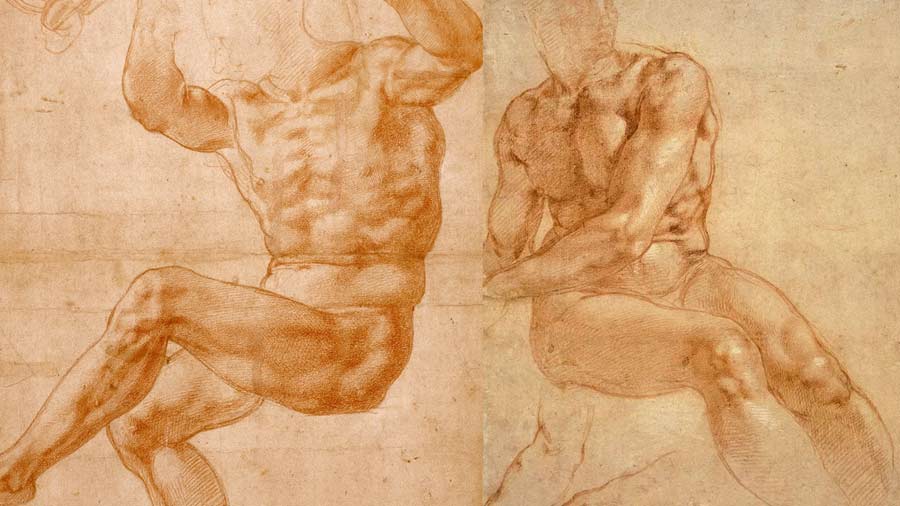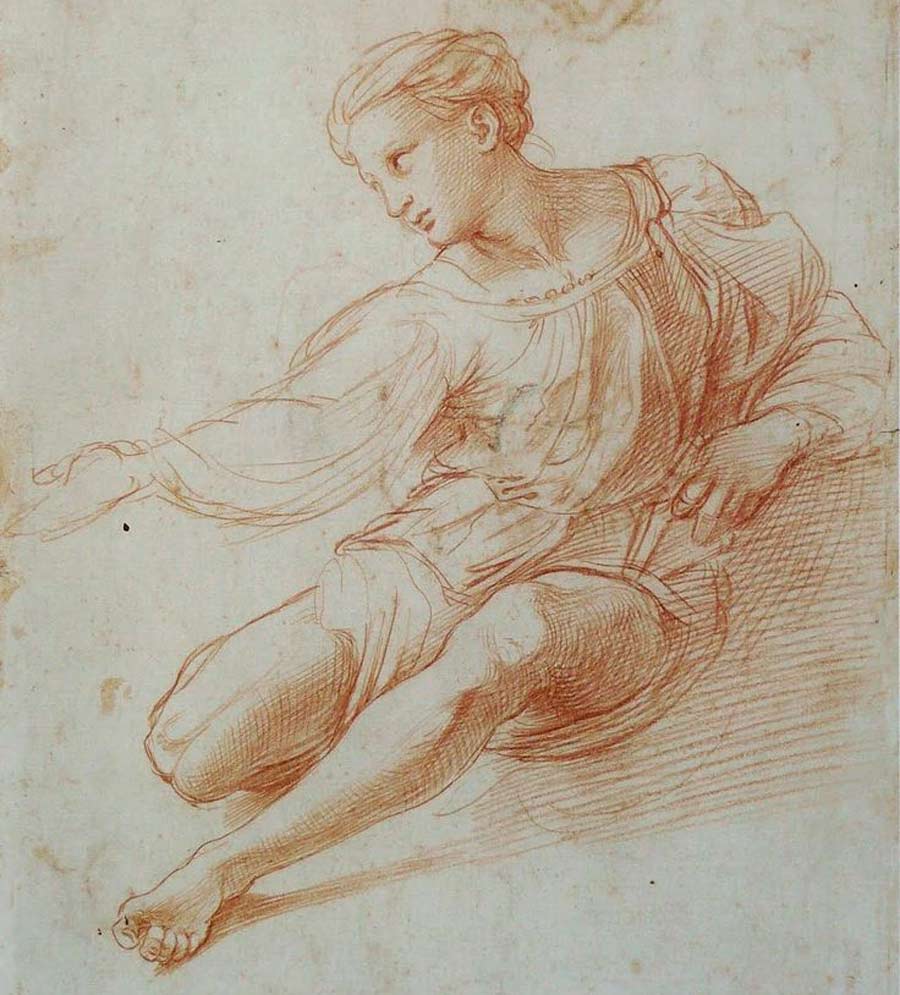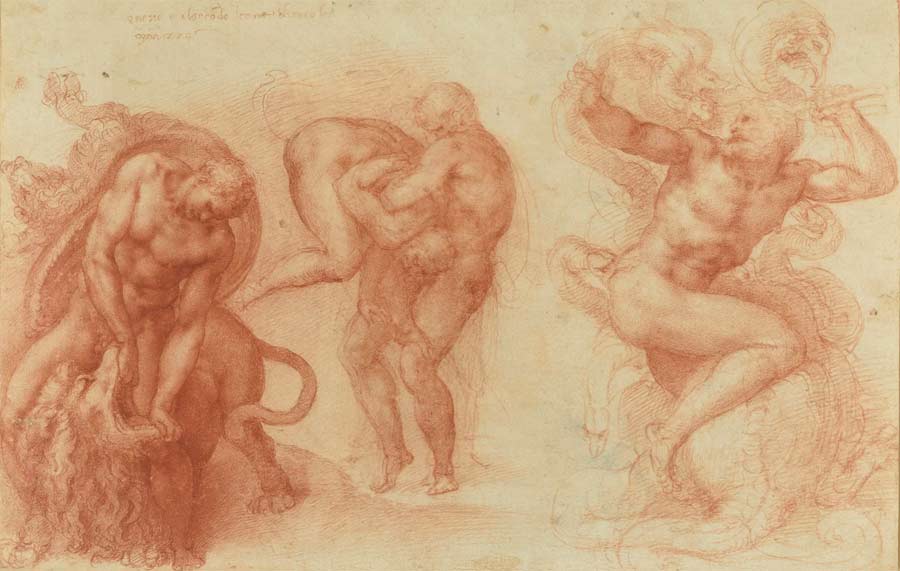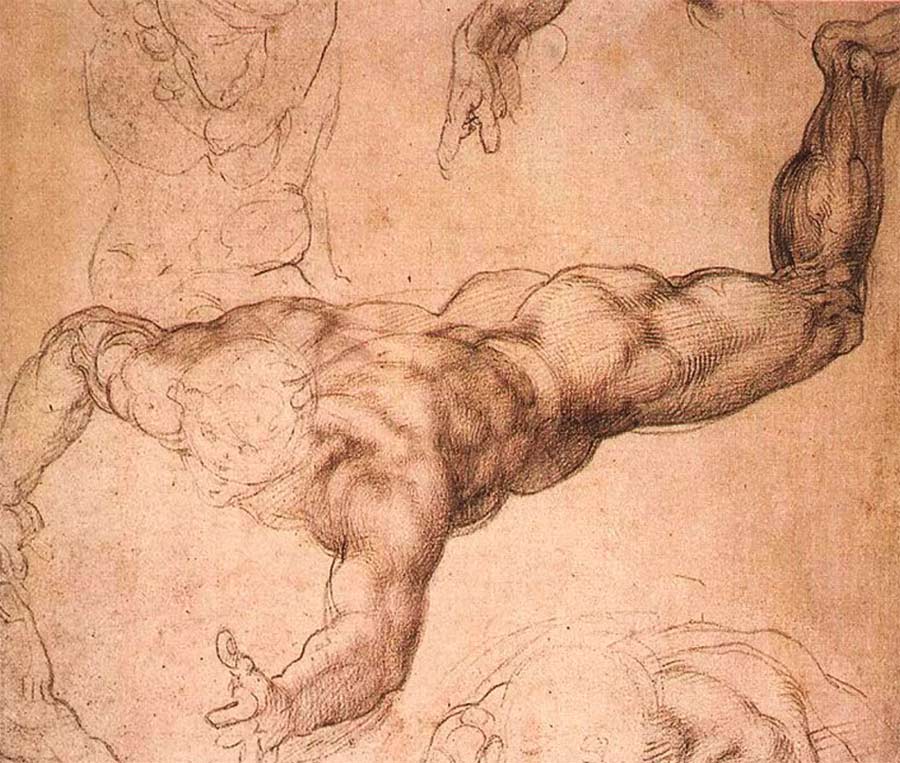What we can learn about Life Drawing from the Old Masters
Enroll in the Life Drawing Academy now!
What we can learn about Life Drawing from the Old Masters
A proficient artist knows that when drawing figures in perspective, it is better to portray cross-contours rather than outlines of the figure.
Cross-contours can reveal the depth and angle of the body when outlines are often misleading and do not fully describe the figure's pose or the position of its parts.
When rendering tonal values, you need to keep in mind that no change in tone is accidental, but depends on the body's anatomy and skeletal construction beneath the skin. Every muscle has its volume and shape that defines planes of the figure on the surface. Such planes have different angles towards the light and therefore different tonal values. Needless to say, only by knowing human anatomy will you be able to do so.

Some of the best examples of such anatomical drawing are left by one of the best artists who ever lived—Michelangelo Buonarroti. You can search the Internet for high-resolution pictures of his drawings and analyse them. You will find that observation alone would not be enough to make such drawings. He spent considerable time and effort learning human anatomy, which enabled him to create his masterpieces.
To make a drawing more interesting and convincing, an artist sometimes renders tonal values not as they appear on the model, but describes in tones what one knows about the anatomy of those parts. This comes back to the statement that a proficient artist draws not what one sees, but what one knows. This is very apparent when you examine of Michelangelo's life drawing.
For example, in this drawing, I purposefully exaggerate the tonal values of some borders between planes, and I render in lighter tones areas that do not contribute information about the body structure. Although it is not exactly how tonal values are seen on the model, this draws the viewer's attention to places that describe model's shapes more vividly. You can learn such an approach from the Old Masters, such as Michelangelo, Leonardo da Vinci, Raphael, Rubens, and many others.
We do not see what we don't know. That is why you have to draw from knowledge rather than copy from life without understanding why tonal values are different. This way, you will train your eyes to spot such tonal gradations.

You may notice that the knee is one of the least explained areas in a majority of amateur life drawings. This is because of lack of understanding of the knee joint anatomy and construction. To help you to overcome this issue, we created a video lesson in the Life Drawing Class that is dedicated to drawing the knee with the full understanding of what lies beneath the surface. You can see that the model's right knee has higher contrast and deeper tones than the rest of the body and therefore takes a visually prominent place in the foreground. This is how aerial perspective works. Aerial perspective is not obvious when you observe a model. Nevertheless, we do not draw from observation, but from knowledge.
If you feel that your knowledge of anatomy could be improved, check out the Anatomy Master Class, where you can learn fast anatomy for artists in the comfort of your home.
You might have seen some videos on YouTube where tonal drawing in graphite pencil starts from one corner of an artwork, and tones are rendered inch by inch in full strength from the first attempt. Don't pick up this bad habit. This is an amateur way of shading and should not be used, especially in life drawing. Such rendering might be applicable when making a handmade carbon copy of a photograph. Copying photos has nothing to do with life drawing, and erroneous methods of rendering won't help you develop good life drawing skills.
Here's another tip for life drawing. If you render with the same intensity the whole plane from the beginning to the end, you will flatten the piece and make it dull. It is better to pay some attention to shading the beginning of the area, and then gradually ease out rendering to the middle of the plane. It doesn't mean you should ignore the middle, just don't overdo it. This creates an illusion of perspective.
Such a method is also appropriate for linear drawing. You can stress in bolder lines the beginning of a shape and ease the pressure on the pencil as you draw lines that are farther away. The same works for details. Those parts of a body that are closer to the viewer should be depicted with more attention to details.

Big-scale drawing often scares contemporary artists who are used to drawing from photographs. Even those artists who do large artworks often trace figures or portraits' outlines using projectors. While there's nothing wrong in using photo equipment in such cases, an artist must know a human body's proportions and rules of perspective that apply to figurative art to avoid the distortions that photographs have. Such large formats are actually very interesting to draw. You can easily go into details that would be too challenging to depict otherwise. You draw with the whole arm and even the body rather than moving just your fingers.
Also, classical one- or two-point perspective would not work well in this case. The Old Masters knew this very well and were drawing foreshortened figures using orthogonal or parallel perspective. They depicted foreshortening of lengths, while keeping proportions of widths intact. For example, in his painting, Mantegna portrayed the figure of Christ in parallel perspective, where sides of the body are parallel to each other, yet the support is depicted in one-point perspective that gives a clear picture of the spatial relationship and a realistic view.

Great artists like Raphael and Michelangelo also used the orthographic view. Somehow this know-how was lost during last 500 years, and contemporary art books are full of grotesque figures in perspective. Here's an example from one well-respected author who teaches drawing figures using common one-point perspective. You can see why such an approach is erroneous when comparing the two figures in green and red to each other. One has very small head and exaggerated legs, while the other has a huge upper body.
So, instead of drawing what an artist sees, he or she must draw what one knows. The knowledge of human body proportions is very important here. Foreshortened figures cannot be drawn simply by measuring the relative sizes of a body. Seen in perspective, those parts of a figure would give a false sense of proportions. For example, in our case, the model's head is farther than his legs from the viewer, and measuring with a pencil the relative proportions of such parts would result in mistakes.
Always have some creative task in mind. Life drawing could be done just for the sake of practicing, but in many cases, artists have a very specific purpose for such exercises. For example, you can do life drawing with the aim of finding an interesting pose for your composition, or to study anatomy, or to study individual features of a portrait and so on. There are many extant life drawings from the Old Masters that feature torsos without heads or some limbs or even smaller parts like hands and fingers. Whatever the task, it is better to learn from nature, making fast sketches and long studies of whatever you need for your figurative artworks.
To learn good drawing techniques, enroll in the Life Drawing Academy course:
Online Course
A self-study, self-paced course for you to learn fundamental methods of classical drawing and improve life drawing skills by watching video lessons and doing assignments
- Unlimited access to 52 life drawing video lessons
- Lifetime membership without deadlines
- Unlimited support from the Academy tutors
- Constructive critique of your artworks
- Member access to the Academy's Art community
- Place in the Academy's Students Gallery
- Exclusive members-only newsletter and bonuses
- Life Drawing Academy Diploma of Excellence in your name
One-time payment - Lifetime membership
$297 USD
Personal Tutoring Online + Online Course
The ultimate choice if you who would like to receive personal, one-to-one tutoring from the Academy teachers, which is custom-tailored to your skills and needs
- Everything in Online Course, plus:
- Dedicated team of art tutors
- Assessment of your current level of drawing skills
- Personalized curriculum tailored to your skills and goals
- Up to 100 drawing tasks with by-task assessment
- Unlimited one-to-one personal coaching with detailed per-task instructions and feedback
- Artwork critiques and results-oriented guidance
One-time payment - Lifetime membership
$997 USD




